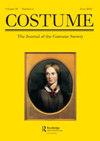前沿服装:海伦·盖尔·弗林特和18世纪服装博物馆在历史悠久的迪尔菲尔德
IF 0.3
4区 社会学
0 HUMANITIES, MULTIDISCIPLINARY
引用次数: 0
摘要
本文考察了海伦·盖尔·弗林特在二十世纪中期在历史悠久的迪尔菲尔德收集和展示十八世纪服装的目标、目的和背景。他们的博物馆是由弗林特和她的丈夫创立的,他们的博物馆诠释了美国乡村生活,只是美国少数专门收集18世纪服装的装饰艺术博物馆之一。无视当时这些机构中普遍存在的偏见,弗林特作为一名收藏家/策展人对时尚的关注更多地反映了其他从事类似活动的女性(主要是英国女性),她在迪尔菲尔德(Deerfield)最终建立的织物厅(Fabric Hall)画廊反映了大西洋两岸(主要是在城市环境中)所做的开创性努力。弗林特的遗产并没有反映出20世纪50年代和60年代新兴的学术,她的展示优先考虑的是华丽的、视觉的和美学的关系,而不是地理和历史的准确性。尽管如此,她开创性的收藏和展示体现了一种切实的承诺,为历史悠久的服装在21世纪的其他装饰艺术中获得应有的地位做出了贡献。本文章由计算机程序翻译,如有差异,请以英文原文为准。
Frontier Dressing: Helen Geier Flynt and Eighteenth-Century Dress Museology at Historic Deerfield
This article examines the goals, objectives and context of Helen Geier Flynt to collect and display eighteenth-century dress at Historic Deerfield during the mid-twentieth century. Founded by Flynt and her husband, their museum interpreting rural American life was just one of a handful of American decorative arts museums specifically collecting eighteenth-century clothing. Ignoring biases prevalent in these institutions at the time, Flynt’s focus on fashion as a collector/curator was more reflective of other, mostly English women engaged in similar activities, and the eventual establishment of her Fabric Hall gallery in Deerfield mirrored ground-breaking efforts undertaken on both sides of the Atlantic, mostly in urban settings. Flynt’s legacy does not reflect the emerging scholarship of the 1950s and 1960s, and her displays prioritized ornate, visual and aesthetic relationships over geographical and historical accuracies. Nevertheless, her pioneering collecting and display embodied a tangible commitment that contributed to historic clothing’s rightful place in the twenty-first century among other decorative arts.
求助全文
通过发布文献求助,成功后即可免费获取论文全文。
去求助
来源期刊

Costume-The Journal of the Costume Society
HUMANITIES, MULTIDISCIPLINARY-
CiteScore
0.40
自引率
50.00%
发文量
27
期刊介绍:
Costume is the journal of the Costume Society. It is a scholarly, refereed, academic publication presenting current research into historic and contemporary dress. The journal publishes articles primarily object-based, from a broad chronological period and with a worldwide remit. Costume maintains a balance between practice and theory and concentrates on the social significance of dress. Articles are welcomed from established researchers and those new to the field. The articles published in Costume are sent out for peer-review to ensure that they are of a high standard and make a contribution to dress history.
 求助内容:
求助内容: 应助结果提醒方式:
应助结果提醒方式:


